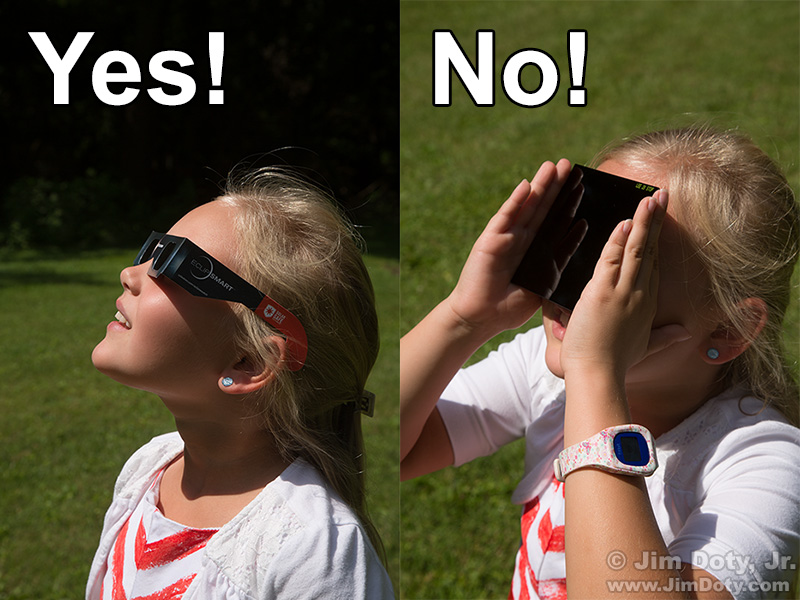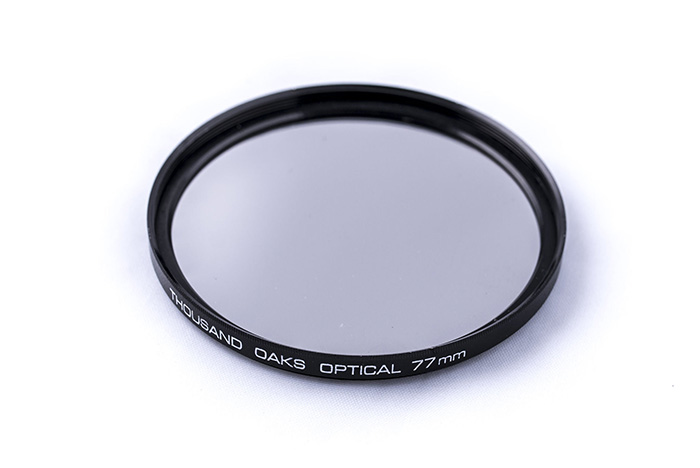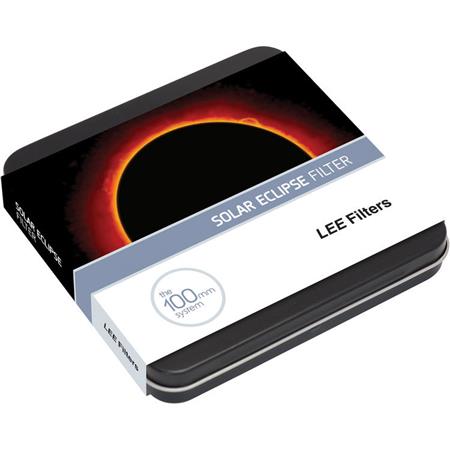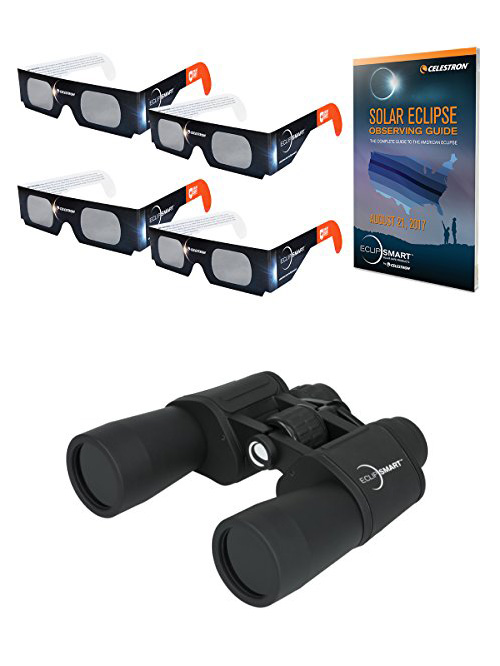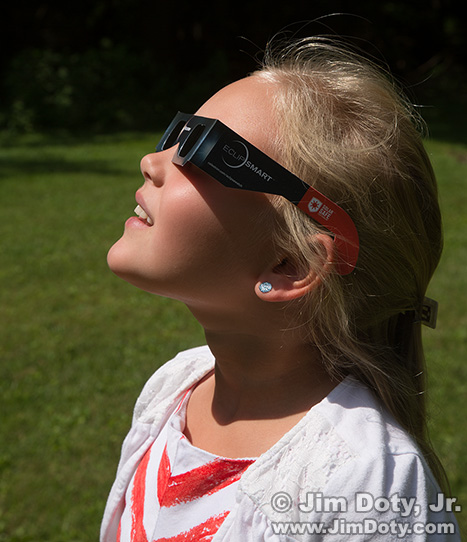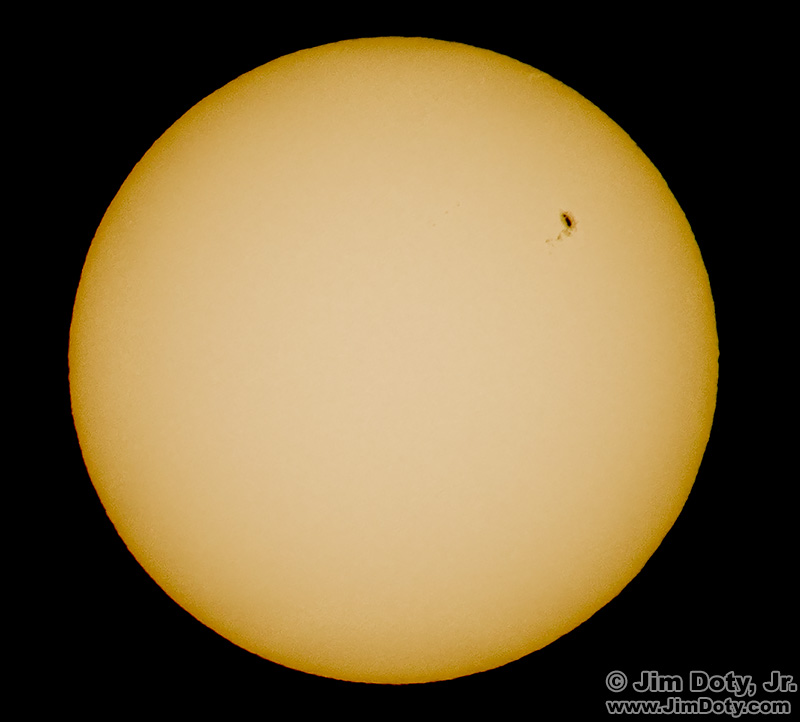Yes, that is right. Do not look at the sun on eclipse day (or any other day) through a solar eclipse filter. Even though you are looking through a solar eclipse filter (i.e. solar filter) you can still go blind. And this is especially true looking through a camera and lens, even with a solar filter on the lens. Why? I am glad you asked.
This article was initially posted Friday, July 14, 2017. Expanded and revised August 4, 2017.
Most Solar Eclipse Filters are NOT Visually Safe
Most Solar eclipse filters (which are the same solar filters photographers use when there isn’t an eclipse) are high density filters. They are designed to reduce the visible light rays so you can take pictures, but they do NOT filter out the invisible rays that can ruin your eyesight. And you have no warning that your are damaging your eyes. You look at the sun through a high density solar filter and you feel fine. A few hours later your eyes may start to hurt. More hours pass and things look a little dark in the center of your vision. The darkness slowly spread across your whole field of view. 24 hours later you are totally blind. Am I trying to scare you? Yes. Going blind through ignorance or stupidity is not fun.
It is even worse when looking through a camera and lens. The sun looks pretty tiny through a camera lens so people tend to zoom the lens longer to make the sun bigger. That just makes things worse, putting your eyesight at even more risk.
This is why the ONLY safe way to take pictures of the sun with a high density solar filter is in “Live View” mode. When you are in live view mode the image from the sensor is sent to the LCD on the back of your camera. You aren’t looking at direct sunlight If your camera does not have Live View mode don’t take pictures of the eclipse. Period. Never ever look at the bright sun through your camera’s viewfinder, solar filter or not. (Sunsets and sunrises where the light rays have been significantly scattered and reduced are an exception.)
Thousand Oaks Optical Solar Filters
There is one exception in terms of solar filters being safe to look through. If you get a White Light solar filter from Thousand Oaks Optical, you can safely look through it to look at the sun. Their filters are visually safe in addition to being photographically safe. With a Thousand Oaks Optical solar filter on your lens, you can safely look through the viewfinder of the camera to take pictures without using Live View mode. However, out of an abundance of caution I still suggest you use Live View mode when you are focus on the sun and then to photograph the sun. One nice thing about solar filters from Thousand Oaks Optical is you get a natural colored sun. With most solar filters you get no color, or you get odd colors. Thousand Oaks Optical makes solar filters for NASA, most of the major news agencies, and most of the university astronomical observatories across the country. They are as good as it gets. As you would expect, they make solar filters for telescopes.
There is now a problem getting a White Light solar filter from Thousand Oaks Optical. Due to huge demands thanks to the coming eclipse, as of July 9 they are so far back ordered that they can no longer guarantee delivery in time for the eclipse. You can try but it is iffy. Go here to order. If they can’t get your filter in time for the eclipse you get a refund.
I should add you might want a solar filter to photograph the sun long after the eclipse is over. Get a size that fits on the front of your telephoto lens.
Lee Solar Filters
I highly recommend Lee solar filters. As of today’s date (July 14) it is still possible to get a Lee solar eclipse filter from Adorama. You will also need a Lee filter holder and a Lee adapter ring. They are photographically safe but not visually safe. More about Lee solar filters in the last full paragraph. For more information and to purchase this filter, go to this link or to the last link at the end of this article..
You can safely look at the eclipse if you have eclipse glasses, goggles, or binoculars from a reputable company. Do not trust your precious eyesight to some Johnny-come-lately company looking to make a fast buck from the eclipse. There is no national agency that prevents the sale of unsafe eclipse glasses and binoculars. I highly recommend you order from Celestron. They have been in the astronomy business for decades. You can order Celestron eclipse glasses, goggles, and binoculars at my Amazon powered photography store. You get the same great Amazon prices, service, and guarantee and you help support this web site. Don’t wait. Order now because they may be out of stock later.
Don’t Wait
I have been urging people for weeks to order well ahead of time. This applies to eclipse glasses, goggles, and binoculars, as well as to solar filters for camera lenses. If you still haven’t ordered, do it ASAP.
Photography with a Lee Solar Filter
The photo at the top of this article was taken earlier today through an excellent Lee solar filter. Despite being an excellent filter optically and photographically, the Lee solar filter is photographically safe but not visually safe, which means do not look at the sun through this filter, and when the filter is on your camera lens DO NOT LOOK THROUGH THE EYEPIECE of the camera. You MUST shoot in Live View mode to protect your eyesight. To learn how to photograph the sun with a solar filter, go here. The sun in the original file is blue, a byproduct of the filter design, so I tinted it yellow using Adobe Camera RAW and Photoshop. This article shows you how.
You can see sunspots in the upper right part of the sun. I used a 100-400mm lens which does not yield a huge sun, so this photo is significantly cropped from the original file.
Viewing and Photographing the Sun During Totality
If you are in the path of totality, and only during totality can you safely look at the sun without solar glasses or solar binoculars. And you can take pictures without a solar filter on the camera lens. But only during totality. Before and after totality (including the Diamond Ring affect and Bailey’s Beads) you must protect your eyes with appropriate solar eclipse glasses or solar eclipse binoculars.
Thanks to the Model
My thanks to the model (and her parents) for posing for these photos. She was carefully instructed not to open her eyes when she had the solar filter in front of her face.
And Finally . . .
This is just one in a series of articles on the Great American Eclipse. See the first link below to keep up with new articles as they are added.
Be careful out there!
The Great American Eclipse Series
The Great American Eclipse Series  – All of my eclipse articles are listed at this link. Check back for new articles as they appear.
More Links
Order eclipse glasses, goggles and binoculars at my Amazon powered photography store
How To Photograph the Sun (and an Eclipse) with a Solar Filter
How to Process a “Blue Sun†Photographed with a Lee Solar Filter
Solar Eclipse Filters – Order Today Before It is Too Late

